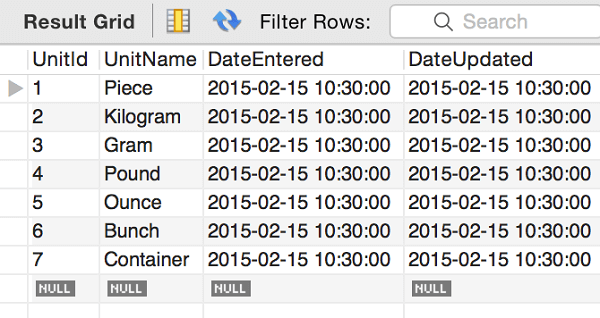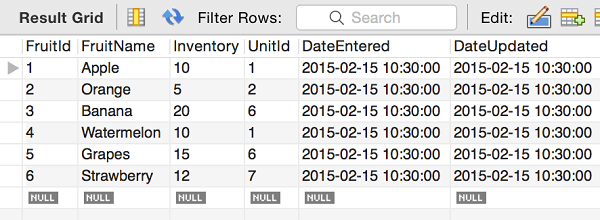Insert Data into a MySQL
The INSERT Statement
The INSERT explanation enables you to add information to your database tables. The linguistic structure goes this way:
{`
Supplement INTO
table_name (col_1, col_2, col_3….)
Qualities (value_1, value_2, value_3….);
`}
This supplements information into one line. The request of the qualities furnished must relate with the segments that the qualities are to be embedded into.
In the event that you are embeddings information into all sections, you can overlook the segment names and simply do this:
Supplement INTO table_name VALUES (value_1, value_2, value_3);
To populate different columns, utilize a comma to isolate each line, this way:
Addition INTO table_name
Qualities
{`
INSERT INTO 'table_name'(column_1,column_2,...) VALUES (value_1,value_2,...);
(value_1, value_2, value_3….),
(value_1, value_2, value_3….),
(value_1, value_2, value_3….),
(value_1, value_2, value_3….);
`}
The above model populates 4 pushes and accept there are 3 sections in each column.
Example
Suppose that we have the following list of new library members that need to be added into the database.
Execute the accompanying SQL content against the FruitShop database:
{`
(1,'Piece','2015-02-15 10:30:00','2015-02-15 10:30:00'),
(2,'Kilogram','2015-02-15 10:30:00','2015-02-15 10:30:00'),
(3,'Gram','2015-02-15 10:30:00','2015-02-15 10:30:00'),
(4,'Pound','2015-02-15 10:30:00','2015-02-15 10:30:00'),
(5,'Ounce','2015-02-15 10:30:00','2015-02-15 10:30:00'),
(6,'Bunch','2015-02-15 10:30:00','2015-02-15 10:30:00'),
(7,'Container','2015-02-15 10:30:00','2015-02-15 10:30:00');
`}
Addition INTO Fruit
Qualities
{`
(1,'Apple',10,1,'2015-02-15 10:30:00','2015-02-15 10:30:00'),
(2,'Orange',5,2,'2015-02-15 10:30:00','2015-02-15 10:30:00'),
(3,'Banana',20,6,'2015-02-15 10:30:00','2015-02-15 10:30:00'),
(4,'Watermelon',10,1,'2015-02-15 10:30:00','2015-02-15 10:30:00'),
(5,'Grapes',15,6,'2015-02-15 10:30:00','2015-02-15 10:30:00'),
(6,'Strawberry',12,7,'2015-02-15 10:30:00','2015-02-15 10:30:00');
`}
Check your Data
You can watch that your information was embedded by executing the accompanying SQL explanations.
Check the Fruit Table
Select all records from the Fruit table by running the accompanying explanation:
select * from Fruit
The Result
MySQL Insert Data 1
The outcome should resemble this.

Check the Units Table
Select all records from the Units table by running the accompanying explanation:
select * from Units
The Result

MySQL Insert Data 2
The outcome should resemble this.
We simply utilized a SELECT explanation to question the information in our database. How about we look all the more carefully at MySQL inquiries.
MYSQL Tutorials
- Create MySQL Database
- Create Table in MySQL
- Insert data to MySQL
- Mysql Queries
- Update data in MYSQL
- Delete data in MySQL
- Default Database
- Primary Key
- Foreign Keys
- Views
- Export MySQL Database
- Import data into Mysql
- Create Website with MySQL
MYSQL Sample Assignments
- COIT20247 Database Design and Development
- Relational schema and MySQL database
- Mysql Project
- ITICT107A Introduction to Databases
- MySql Assignment Question
MYSQL Sample Solutions
- Solution - COIT20247 Database Design
- Solution - Relational schema and MySQL
- Solution - Mysql Project
Testimonials
Very affordable projects!! And that to submit before deadlines. Thanks for helping me in my database project and raising my grades. I have been able to secure good marks in my internal assessment only because of you. Read More

